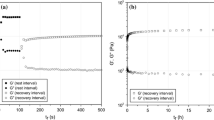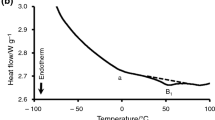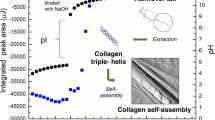Abstract
In this paper, a TG/DTG–DSC–FTIR study of type I collagen extracted from bovine Achilles tendon both in inert (nitrogen) and oxidative atmosphere (synthetic air and oxygen) from room temperature to 700 °C was performed. The thermal analysis results have shown that after initial dehydration, collagen exhibits a single decomposition step in nitrogen (due to pyrolysis), while in air and oxygen two steps are observed due to thermo-oxidative decomposition, the latter being highly exothermic. The CO2 bands dominate the FTIR spectra of evolved gases in all atmospheres (especially in air and oxygen), along with the characteristic bands of ammonia, water, HNCO, methane. In nitrogen, the bands of pyrrole, HCN, and ethane were also identified, while in oxidative atmospheres, nitrogen oxides and CO are released. A study was also performed by comparing the DTG and gas evolution curves observed for the three atmospheres.











Similar content being viewed by others
References
Fratzl P, editor. Collagen: structure and mechanics. New York: Springer; 2008. p. 49–80.
Pietrucha K. Changes in denaturation and rheological properties of collagen–hyaluronic acid scaffolds as a result of temperature dependencies. Int J Biol Macromol. 2005;36:299.
Davidenko N, Campbell JJ, Thian ES, Watson CJ, Cameron RE. Collagen–hyaluronic acid scaffolds for adipose tissue engineering. Acta Biomater. 2010;6:3957–68.
He L, Mu C, Shi J, Zhang Q, Shi B, Lin W. Modification of collagen with a natural cross-linker, procyanidin. Int J Biol Macromol. 2011;48(2):354–9.
Sionkowska A, Wisniewski M, Skopinska J, Poggi GF, Marsano E, Maxwell CA, Wess TJ. Thermal and mechanical properties of UV irradiated collagen/chitosan thin films. Polym Degrad Stab. 2006;91:3026–32.
Lungu A, Albu MG, Florea NM, Stancu IC, Vasile E, Iovu H. The influence of glycosaminoglycan type on the collagen-glycosaminoglycan porous scaffolds. Dig J Nanomater Bios. 2011;6(4):1867–75.
Horn MM, Amaro Martins VC, de Guzzi Plepis AM. Interaction of anionic collagen with chitosan: effect on thermal and morphological characteristics. Carbohydr Polym. 2009;77:239–43.
Budrugeac P, Miu L, Popescu C, Wortmann FJ. Identification of collagen-based materials that are supports of cultural and historical objects. J Therm Anal Calorim. 2004;77:975–85.
Popescu C, Budrugeac P, Wortmann FJ, Miu L, Demco D, Baias M. Assessment of collagen-based materials which are supports of cultural and historical objects. Polym Degrad Stab. 2008;93:976–82.
Badea E, Miu L, Budrugeac P, Giurginca M, Mašić A, Badea N, Della Gatta G. Study of deterioration of historical parchments by various thermal analysis techniques complemented by SEM, FTIR, UV–Vis–NIR and unilateral NMR investigations. J Therm Anal Calorim. 2008;91:17–27.
Onishi A, Thomas PS, Stuart BH, Guerbois JP, Forbes SL. Tg–Ms analysis of the thermal decomposition of pig bone for forensic applications. J Therm Anal Calorim. 2008;92(1):87–90.
Onishi A, Thomas PS, Stuart BH, Guerbois JP, Forbes SL. Tg–Ms characterisation of pig bone in an inert atmosphere. J Therm Anal Calorim. 2007;88(2):405–9.
Mkukuma LD, Skakle JMS, Gibson IR, Imrie CT, Aspden RM, Hukins DWL. Effect of the proportion of organic material in bone on thermal decomposition of bone mineral: an investigation of a variety of bones from different species using thermogravimetric analysis coupled to mass spectrometry, high-temperature X-ray diffraction, and fourier transform infrared spectroscopy. Calcif Tissue Int. 2004;75:321–8.
Lozano LF, Peña-Rico MA, Heredia A, Ocotlán-Flores J, Gómez-Cortés A, Velázquez R, Belío IA, Bucio L. Thermal analysis study of human bone. J Mater Sci. 2003;38:4777–82.
Budrugeac P, Miu L. The suitability of DSC method for damage assessment and certification of historical leathers and parchments. J Cult Heritage. 2008;9:146–53.
Budrugeac P, Badea E, Della Gatta G, Miu L, Comănescu A. DSC study of deterioration of parchment exposed to environmental chemical pollutants (SO2, NO x ). Thermochim Acta. 2010;500:51–62.
Cucos A, Budrugeac P, Miu L, Mitrea S, Sbarcea G. Dynamic mechanical analysis (DMA) of new and historical parchments and leathers. Correlations with DSC and XRD. Thermochim Acta. 2011;516:19–28.
Samouillan V, Lamure A, Lacabanne A. Dielectric relaxations of collagen and elastin in the dehydrated state. Chem Phys. 2000;255:259–71.
Bozec L, Odlyha M. Thermal denaturation studies of collagen by microthermal analysis and atomic force microscopy. Biophys J. 2011;101:228–36.
Roduit B, Odlyha M. Prediction of thermal stability of fresh and aged parchment. J Therm Anal Calorim. 2006;85(1):157–64.
Kurata S, Ichikawa K. Identification of small bits of natural leather by pyrolysis gas chromatography mass spectrometry. Bunseki Kagaku. 2008;57(7):563–9.
Marcilla A, García AN, León M, Martínez P, Bañón E. Study of the influence of NaOH treatment on the pyrolysis of different leather tanned using thermogravimetric analysis and Py/GC–MS system. J Anal Appl Pyrol. 2011;92:194–201.
Lodowska J, Wolny D, Kurkiewicz S, Węglarz L. The Pyrolytic Profile of Lyophilized and Deep-Frozen Compact Part of the Human Bone. Sci World J. 2012(2012) Article ID 162406, 7 pages doi:10.1100/2012/162406.
Purevsuren B, Avid B, Gerelmaa T, Davaajav Ya, Morgan TJ, Herod AA, Kandiyoti R. The characterisation of tar from the pyrolysis of animal bones. Fuel. 2004;83:799–805.
Li J, Wang Z, Yang X, Hu L, Yuwen L, Wang C. Decomposing or subliming? An investigation of thermal behavior of l-leucine. Thermochim Acta. 2006;447:147–53.
Li J, Wang Z, Yang X, Hu L, Yuwen L. Evaluate the pyrolysis pathway of glycine and glycylglycine by TG–FTIR. J Anal Appl Pyrol. 2007;80:247–53.
Li J, Yuwen L, Jingyan S, Wang Z, Hu L, Yang X, Wang C. The investigation of thermal decomposition pathways of phenylalanine and tyrosine by TG–FTIR. Thermochim Acta. 2008;467:20–9.
Kruse J, Eckhardt K-U, Regier T, Leinweber P. TG–FTIR, LC/MS, XANES and Py-FIMS to disclose the thermal decomposition pathways and aromatic N formation during dipeptide pyrolysis in a soil matrix. J Anal Appl Pyrol. 2011;90(2):164–73.
Mocanu AM, Moldoveanu C, Odochian L, Paius CM, Apostolescu N, Neculau R. Study on the thermal behavior of casein under nitrogen and air atmosphere by means of the TG-FTIR technique. Thermochim Acta. 2012;546:120–6.
Liu X, Gu S, Xu W. Thermal and structural characterization of superfine down powder. J Therm Anal Calorim. 2013;111(1):259–66.
Brebu M, Spiridon I. Thermal degradation of keratin waste. J Anal Appl Pyrol. 2011;91:288–95.
Shen DK, Gu S. The mechanism for thermal decomposition of cellulose and its main products. Bioresour Technol. 2009;100:6496–504.
Liu Q, Wang S, Zheng Y, Luo Z, Cen K. Mechanism study of wood lignin pyrolysis by using TG–FTIR analysis. J Anal Appl Pyrol. 2008;82(1):170–7.
Agostini DLS, Constantino CJL, Job AE. Thermal degradation of both latex and latex cast films forming membranes. Combined TG/FTIR investigation. J Therm Anal Calorim. 2008;91(3):703–7.
Giuntoli J, de Jong W, Arvelakis S, Spliethoff H, Verkooijen AHM. Quantitative and kinetic TG-FTIR study of biomass residue pyrolysis: dry distiller’s grains with solubles (DDGS) and chicken manure. J Anal Appl Pyrol. 2009;85:301–12.
Marcilla A, Gómez-Siurana A, Gomis C, Chápuli E, Catalá MC, Valdés FJ. Characterization of microalgal species through TGA/FTIR analysis: application to nannochloropsis sp. Thermochim Acta. 2009;484:41–7.
Tănase C, Odochian L, Apostolescu N, Pui A. TG–FTIR analysis applied to the study of thermal behaviour of some edible mushrooms. J Therm Anal Calorim. 2011;103:1079–85.
NIST Chemistry Webbook Standard Reference Database No. 69, June, 2005 Release (http://webbook.nist.gov/chemistry).
Stevens FS, Jackson DS. Purification and amino acid composition of monomeric and polymeris collagens. Biochem J. 1967;104:534–6.
Britt PF, Buchanan AC, Owens CV, Skeen J. Does glucose enhance the formation of nitrogen containing polycyclic aromatic compounds and polycyclic aromatic hydrocarbons in the pyrolysis of proline? Fuel. 2004;83:1417–32.
Acknowledgments
This work was supported by a grant of the Romanian National Authority for Scientific Research, CNCS-UEFISCDI, Project Number PN-II-RU-PD-2011-3-0047.
Author information
Authors and Affiliations
Corresponding author
Rights and permissions
About this article
Cite this article
Cucos, A., Budrugeac, P. Simultaneous TG/DTG–DSC–FTIR characterization of collagen in inert and oxidative atmospheres. J Therm Anal Calorim 115, 2079–2087 (2014). https://doi.org/10.1007/s10973-013-3116-1
Received:
Accepted:
Published:
Issue Date:
DOI: https://doi.org/10.1007/s10973-013-3116-1




